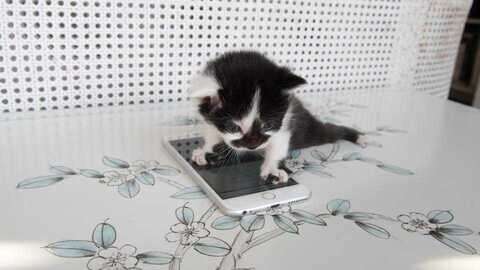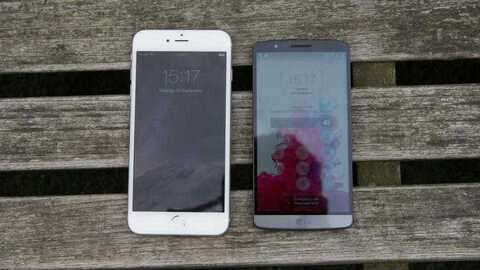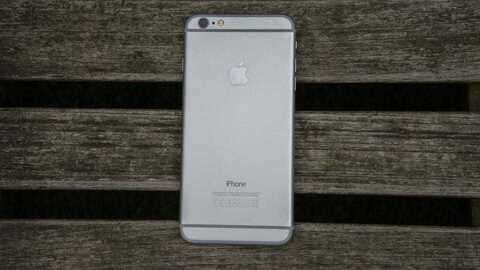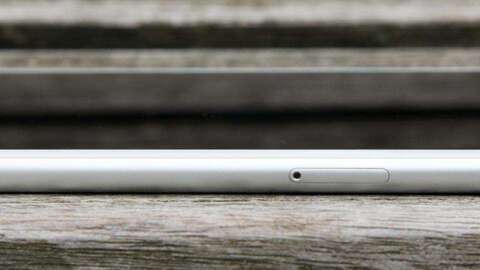Apple iPhone 6 plus Apple iPhone 6 Plus review: Discontinued and replaced by the iPhone 6S Plus
The iPhone 6 Plus was released in September 2014. The phone was then superseded by the iPhone 6S in September 2015 with the 128GB model of the iPhone 6 being removed from shelves, and then later completely discontinued in September 2016 with the launch of the iPhone 7 and the refreshed 32GB iPhone 6 Plus.

This means the phone is now very hard to find brand-new. You'll be able to find a few refurbished phones on eBay . At around £250 refurbished, it's an excellent price for a competent iPhone, however, if you're really keen on getting an iPhone, we'd suggest getting a brand-new 32GB iPhone 6S instead; this will set you back around £549, but can still be found on contract .
Continue reading for David's original review that was written in September 2014 and based on the 16GB model running iOS 8. If you buy an iPhone 6 used, refurbished or miraculously new, then it can be upgraded to Apple's latest software, iOS 12.
READ NEXT: Apple iPhone 6S Plus review: The last large-sized iPhone of its kind
Apple iPhone 6 Plus review
It's been a long time coming, but Apple has finally made a big-screen phone - and we have to say that the results are well worth waiting for. It may be too big for some, but we found it easy to get used to the iPhone 6 Plus' 5.5in screen and now prefer this to the smaller iPhone 6 . As well as being bigger, Apple has massively improved battery life, with the phone lasting for ages, particularly in normal use when the screen's not on all of the time.
Although Apple has stuck with an 8-megapixel sensor, in terms of noise, exposure and quality, the iPhone 6 Plus' camera is one of the best in the business, helped by its optical image stabilisation. With its fast processor and incredibly slick operating system, iOS 8.3, this is the best iPhone that you can buy, and one of the best smartphones. For people that can't make up their mind between iOS and Android, the Samsung Galaxy S6 Edge gives this phone a run for its money, while our best smartphone guide will list something suitable if neither of these phones really takes your fancy.
READ NEXT: The best smartphones – our pick of the best
iPhone 6 Plus review: Design
All of Apple's advertising may say that the new model's 'Bigger than bigger', but you don't truly appreciate the size of the iPhone 6 Plus until you pick it up for the first time. It's then that you realise that it's an absolute beast of a phone, with its big 5.5in screen dominating the front.
This is the same size screen as on the LG G3 , but the iPhone 6 Plus is considerably taller and the much bigger phone. Measuring 158x77x7.1mm, it's almost the same height as the Google Nexus 6 , which measures 159mm high and has a massive 6in screen. Admittedly, the Nexus 6 has a much wider girth at 83mm to accommodate its larger display, but the iPhone 6 Plus certainly has a lot of excess bezel compared to your other 5.5in handsets we've tested in the past year.
This is largely due to the need to fit the TouchID fingerprint sensor underneath the screen, and we suspect that the larger bezel at the top is to keep the phone symmetrical. This time around Apple has gone for a smooth curved design, with the glass curving down to meet the aluminium body. As well as giving it nicer feel, compared to the iPhone 5S ' sharper, squared-off edges, it makes the iPhone 6 Plus that bit grippier in the hand. It helps that it weighs just 172g (it's heavier than plastic-made phones, but we'd take a bit more weight and metal any day) and is only 7.1mm thick, as these factors stop the phone from feeling too bulky in your hand.

Since we first reviewed the handset we've had time to carry it around and use it as our primary phone for a good few months. As a result, we've updated our review and have an entire section on whether the handset is too big or not.
Of course, the iPhone 6 Plus looks every bit as gorgeous as previous models. Absolute precision engineering and the full aluminium body give this phone that reassuringly-premium feel that we've come to expect from Apple. Metal panels are joined with plastic inserts, which are most likely there to improve mobile reception, with metal notoriously bad at blocking signals. While this could look a little cheap, Apple's joined to the two together well and the handset looks fantastic. As with the 5S, the handset is available in Space Grey, Silver and Gold. All colours are neatly done, so it's really a matter of personal preference as to which one you want.
Some people have complained that the iPhone 6 Plus bends . Apparently, the issue comes from the handset being kept in tight back pockets, bending out of shape when people sit down. We've not run into this problem ourselves, Apple has put the handset through strenuous tests, and most the videos showing the handset bending have used excessive force. In any case, the tough sturdy frame of the iPhone 6 Plus feels rigid enough. It goes without saying that, as with any expensive piece of electronics, it's worth treating the phone with care.

As the phone is so much larger than previous models, Apple has had to change the design slightly. Most noticeable is that the power button has moved from the top to the right-hand side of the phone, where it's easier to reach with a finger or thumb, depending on which hand you're holding it in. It can still be a little bit of a reach, particularly for people with small hands - it's another good reason to try the phone in store before you buy to make sure that you're comfortable with the size.

On the other side of the handset, it's business as normal, with the volume buttons and the silent mode rocker switch still there. We're pleased to see that this physical switch still exists (it looks set to be taken off the iPad Air 2 ), as it's still the most convenient and easiest way of turning on a silent mode, on any current phone.
Is it too big?
One of the main questions that people have about this handset is, is it too big? After carrying this handset around since launch, we think that we're fairly qualified to answer that question. Size is largely relative and getting used to the iPhone 6 Plus takes a bit of time, particularly if you had an iPhone 5S. That smartphone was, by modern standards, quite small, so there's a bit of 'screen shock' when you first pick up the iPhone 6 Plus.
Hold it and use it for a while and you soon start to appreciate that it's exceptionally well designed and comfortable to hold. After a bit you start to forget that the phone is so big and it just starts to feel natural - you certainly don't feel like a fool making a phone call on one. We much prefer it to the Nexus 6, which most of the team struggled to use single-handedly. Realistically, you're going to be using the phone with two hands, but at least Apple's new Reachability feature (more on this on the next page), which moves the whole screen down within reach of your thumb, gives some provision for one-handed use, which is more than we can say for the Nexus 6.
Once you've been using the iPhone 6 Plus for a while, the opposite starts to happen and other phones start to feel too small: our iPhone 5S now feels a bit like a child's toy. With all of that said, there's no getting away from the fact that for some people this phone is just going to be too big. At its size, it doesn't fit comfortably into a coat's inside pocket and you certainly know it's there when you put it in a trouser pocket. Depending on the size of your hands, you may find that this handset just is too big.
While that may sound like we're not really answering the question, the simple answer is: the iPhone 6 Plus is extremely well designed for a large phone, but it's all down to personal choice. Fortunately, you can try this handset out in an Apple store to get a feel for it in person while the regular iPhone 6 has pretty much all of the same features in a slightly smaller size. Really, that's what the iPhone 6 range is about for Apple: giving people real choice, so that they can get the phones that suit them. To get a better idea of size, you can check out our article comparing the relative sizes of Apple's phones and tablets .
iPhone 6 Plus review: Display
Of course, it's the display that's going to get all of the attention, as the 5.5in display takes up the bulk of the front of the handset. It doesn't have the much-rumoured sapphire glass that everyone was hoping for, but has ion-strengthened glass instead. This is scratch and shatter resistant, but it still pays to be careful with the handset and a case or screen protector is a must.
In order to keep to its policy of shipping Retina devices, where you can't see individual pixels at normal viewing distances, Apple has had to increase the pixel count from the iPhone 5S' display, giving the iPhone 6 Plus a Full HD (1,920x1,080) display.
The LG G3 has a higher 2,560x1,440 resolution. In fairness side-by-side, its screen is slightly sharper, particularly when viewing high-resolution photos. However, it's not streets ahead in terms of sharpness and in day-to-day use, particularly with text, you're not likely to really see many differences. At 401 pixels per inch (ppi) it's fair to say that the iPhone 6 has enough resolution and its screen is more than sharp enough. Besides, adding more pixels would most likely increase drain on the battery and put more strain on the CPU, too. If you care about having the highest-resolution phone, then this isn't the model for you; if you want a sharp clear display as part of a bigger package, then the iPhone 6 Plus is a great choice. Besides, the LG G3 has a rather dim screen in comparison.
As usual, Apple has stuck with LCD technology for the display, fitting an LED-backlit IPS panel. The display has dual-domain pixels, which help improve viewing angles. There have been some complaints about screens that use this technology before saying that black can look a bit purple; we didn't get this on the iPhone 6 at all. Viewing angles are superb. Compared side-by-side with the iPhone 5S, at extreme angles the older phone takes a slight purple-tinge to the screen, but the iPhone 6 maintains its pure colours.
Black levels and contrast are said to have been improved for the iPhone 6 Plus, and the readings from our colour calibrator seemed to confirm this with a low black level of 0.4cm/m2 and a contrast ratio of 1,403:1. That's one of the best results we've seen from an LCD display, managing deep blacks and great contrast. Screen brightness is also very good at 572.13cm/m2. There are few screens brighter than this, and it tells, as we found the phone incredibly easy to view outside. Even better, a new polarised filter on top means that colours stay accurate when you wear sunglasses. Wearing sunglasses we found that our iPhone 5S had a slight purple tinge to it, where as the iPhone 6 Plus did not.
Colour accuracy is something that's hard to measure. DisplayMate tested the iPhone 6 Plus and measured colour reproduction at more than 100 per cent of the sRGB colour gamut; sister-site PC Pro registered coverage at 95.5 per cent of sRGB; our own calibrator said that it was producing 90.5 per cent of the sRGB colour gamut. Given that ourselves and PC Pro use the same software and the same colour calibrator, it would appear as though Apple uses two different panels. From the graph below, measured from our iPhone 6 Plus, most of the slightly-reduced coverage appears to be in the red portion of the spectrum, with the phone displaying a little more blue and green than the gamut defines. Still, that kind of score is still pretty good and puts the iPhone 6 Plus on a level with the LG G3 and HTC One (m8). Using our test photographs it's hard to see any issues with the screen, and fine detail and vibrant colours were all displayed well.